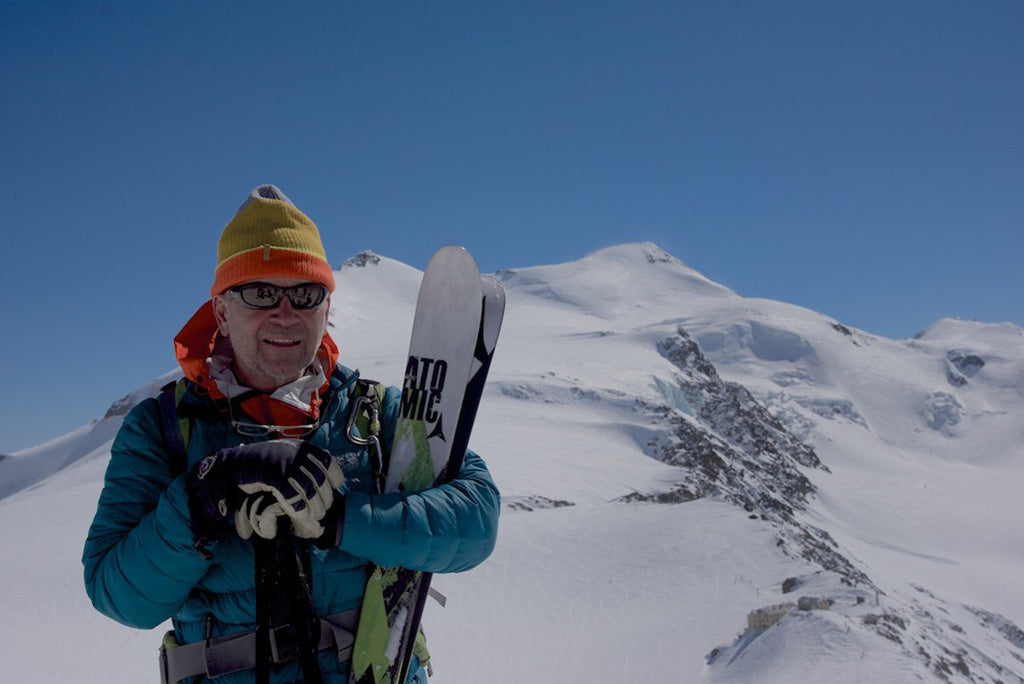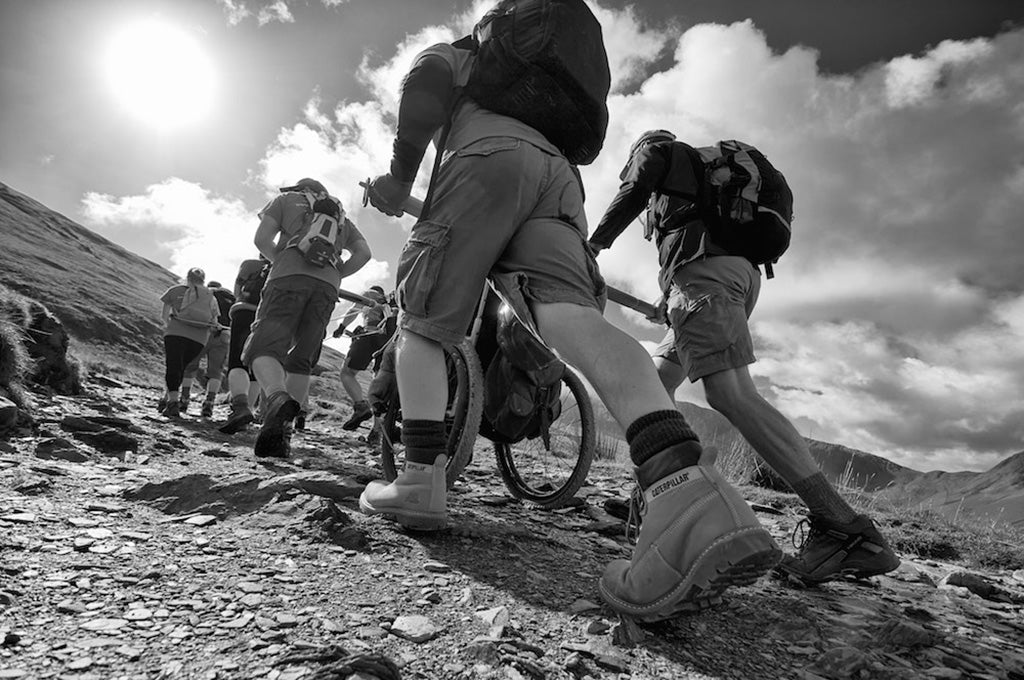mahabis ambassador // konrad bartelski, on skis and mahabis

In 1981, Konrad Bartelski became the best performing British skier in the Alpine Skiing Downhill World Cup with a finish time just 0.11 seconds behind Austria’s Erwin Resch.
Having conquered the World Cup Circuit, Bartelski has since moved into presentation and commentary roles for TV and radio. We talk to Bartelski about this shift to working behind the camera and his life since mastering the slopes.
Swapping between his skis and mahabis, Britain's most successful World Cup downhill racer tells us how he chooses to unwind.
How did you first get involved in skiing? Give us a bit of background on the path you’ve taken to where you are today...
During the war my father was doing his flight training in Canada, and on his free days he visited Banff and the surrounding Rocky Mountains.
It was that visit that so inspired him, that he decided once he had children, he would take them to the mountains in winter to learn to ski. That is how my brother and I ended up in Kitzbuhel, in Austria, on our very first ski holiday.
Skiing became our annual family holiday and we always returned to Kitzbuhel in January. Which was in the week before the famous Hannenkahm Race down the fearsome Streif downhill. So I became familiar with the mystic of downhill racing from an early age, although it wasn’t until I was 11 years old that I actually got to see the race.
Whilst watching the British racers at the tail-end of the race, my ski instructor said “After the show you bring on the clowns”, and that cemented my ambition to try and show that someone from Britain could compete on the downhill World Cup circuit.
 photo: 'the trees', hakuba - japan
photo: 'the trees', hakuba - japan
In 1981, you recorded the highest ever finish for a British skier in a downhill race. You've mentioned previously one of your main motivations was to change the perception of British skiers and compete with the French and Austrians at their own game... Since your win, do you think the perception has changed?
It was my ambition to change that perception, yet ironically I still hear the excuse that we have no mountains and no snow and hence we cannot ever compete with the Austrians and the French etc.
Even though we had demonstrated that it was possible to compete, as had Gina Hawthorn, Davina Galicia and Felicity Field by finishing 4th, 8th and 6th in the Slalom, Giant Slalom and Downhill at the 1968 Grenoble Olympic Winter Games, journalists still suggest that it is an impossible task. Ironically when Alain Baxter was competing so successfully in slalom at the turn of the century, he was adored in the Alps, yet by and large, ignored in the UK.
So the efforts were slow to change the perception and certainly there is more work to be done there.
For example, I was more surprised at the comments when Jenny Jones won the Bronze Medal at the Sochi Olympic Winter Games and how most of the journalists were saying "remarkable that someone from a country without snow could compete to that level."
Yet that very week, Britain’s very own Cairngorms mountains were experiencing their largest snowfall for more than fifty years. The BBC’s Olympic coverage took six days to even mention anything about the five Scottish ski resorts having a bumper season. That British Ski and Snowboard had 6 top ten results at Sochi is evidence enough that the UK can compete at Snowsports.
 photo: konrad skinning on the ortler tour
photo: konrad skinning on the ortler tour
In addition to your 1981 triumph, you're also well known for one of the most famous wipes of all time- your crash at Megève, 1975. Tell us a little more about this event and how it changed things for you?
The crash was hugely frustrating for me, as that race had been going really well and I could have had a strong result. So I was more concerned about the fact that I had messed up a good opportunity.
I did want to get back on my skis as soon as possible, and tried to race just under a month after the crash.
However on that first training run I could not remember how to make a turn, so I had to delay my return by a week.
I had sustained quite serious concussion in the crash and these days the medical staff would not let athletes back on a downhill for around 6 months. In the seventies, we didn’t really have a medical staff.
The adrenaline involved in downhill racing must be an unbeatable feeling. Aside from your 1981 podium finish, what would you say has been your best memory from the slopes?
The adrenaline rush is certainly huge in downhill racing, as it is very much the ultimate “man against the mountain” challenge, so it is quite addictive. Hence my eagerness to get back on the skis.
 photo: mathieu ottobon - sainte foy, france
photo: mathieu ottobon - sainte foy, france
I was so fortunate to have thousands of special memories from the slopes and the world of downhill racing, yet what was most memorable was when I was 19 years old. That was in the 1973/74 season and was the first real breakthrough, after 20 months of consecutive hard work and I started the season off with a 22nd and a 25th in two World Cup downhills.
I remember not being excited or content with the results, just even more determined to improve, and I followed that with a 3rd place in an European Cup race in La Foux D’Allos, France and where my best friend and team mate, Peter Fuchs was 10th.
So having 2 Brits in the top ten was especially exciting.
Our next race was the World Championships in St Moritz and Peter Fuchs and I finished 19th and 15th in the downhill, so having 2 Brits in the top 20 at the World Championships was a tremendous vindication for the battle and strife that we collectively had gone through with the National Governing Body to set up our own quality race training programme.
Over your skiing career, you must have invested heavily in performance wear- and wearing the correct footwear must have been pretty important!
But since retiring from the World Cup circuit and receiving surgery for your knee injury (and swapping your skis for mahabis!), have you taken more time to put your feet up?
Downhill racing is quite similar to Grand Prix Formula 1 racing, as the technology is hugely influential to the final results, so much time and thought is given to seeking the best technical solutions. Even in 1973 we were spending time in wind-tunnels in Farnborough, searching for a competitive edge, as well as working hard on our ski boots and skis, to find the best options for the highest speeds. There were many “Heath Robinson” solutions, yet they were effective. Certainly getting the closest and tightest fit in our ski boots was achieved by much chipping and cutting away on the plastic shells and squeezing our feet in the smallest possible boots.
 photo: konrad on the ortler tour, south tirol, italy
photo: konrad on the ortler tour, south tirol, italy
I retired more than 32 years ago and since then I have been finding a way to pay the bills and so haven’t really had too much time to put my feet up!
The mahabis slippers where purchased to compliment my skis, as they are warm and lightweight and perfect for the Mountain Huts on a Tour like the one that I just completed around the Ortler, South Tirol, Italy.
Konrad's mahabis of choice:
Classic larvik light grey with grey soles. Check them out here.

As well as your athletic pursuits, you also have an interest in photography and have enjoyed spending time behind the camera in more recent years. Tell us more about your Neve & Noor venture and your work in television.
I enjoy my skiing now, as much as I ever did, although I have returned to the type of skiing that originally captivated me when I was learning in Kitzbuhel. And that is to get as far away from the maddening crowd as possible.
So ski touring in different and interesting countries and mountain ranges is what motivates me throughout the winter.
Even when I was competing I used always travel with a camera, as we were fortunate to train in such interesting places like Argentina, new Zealand and Australia in the summer, so to help pay for the costs of travelling long distance I would try and sell a few photos to Ski Welt, an Austrian skiing magazine.
 photo: 'the trees' - hakuba, japan
photo: 'the trees' - hakuba, japan
It was when I working with ESPN in London on their launches of their European and UK TV channels, that I caught up with the new digital age of photography. Hence when I took up travelling to remote places, I was able to start building a portfolio that tried to capture the emotions of the beautiful wildernesses that I was privileged to visit.
The Neve and Noor venture is a new portal for designers searching for interesting and original accessories for their projects and has been set up by my daughter, who is also an Interior Designer.
When the site launches in a couple of months time, there will be a selection of ceramics, soft furnishings, art work and photography from a variety of interesting photographers, such as Dave Watts, Elizabeth Gottwald, Keoma Zac and myself.
The day-to-day challenges of your job now must be quite different, what are some of the difficulties that you have found in being involved in television production and broadcasting?
The day to day challenges of the TV production and broadcasting are totally polarised compared to ski racing. First of all, although everyone takes their work very seriously, there is not the tight rope of having a cliff on one side and a rock face on the other, on a mountain at 85 mph. And the beauty about ski racing is that the measurement by the stopwatch is pure and final. With television everything is really subjective, so there is greater influences from unpredictable insecurities and personalities, which often detracts from the real issues.
Both are very competitive environments, yet the rules are far more black and white in ski racing, so there is a huge adjustment that needs to be made in the transition from sport to business.
 photo: 'ice statues' - monte rosa, italy
photo: 'ice statues' - monte rosa, italy
How do you choose to unwind after a busy day? And has the way your experience downtime changed since you moved from the ski circuit?
Now that I left the TV business, I find that I unwind in the same way that I do when I was ski racing. My photography has become my main focal point and my interest in music is reinvigorated to the same level as it was forty years ago.
As has the ability to stretch the legs during the day. It continues to amaze me just how spectacular our city really is. Once we step out of the door and explore around, by avoiding the usual means of transport. It might take 20 or 30 mins longer to get somewhere, yet there is so much more to absorb.
And then there is the Back Up Trust that I endeavour to help where possible. Back Up transforms lives after spinal cord injuries and offers hugely valuable service to so many who are less fortunate.
 photo: the back up push, racing wheelchairs up and down mount snowdon, wales.
photo: the back up push, racing wheelchairs up and down mount snowdon, wales.
If you had a 25th hour in the day, how would you choose to spend it?
Another hour a day skinning up a mountain would reap the most inspiring rewards.
If you enjoyed this post, you can give it a share using this ready-to-go tweet. You can also find out more about Konrad's photography here.


